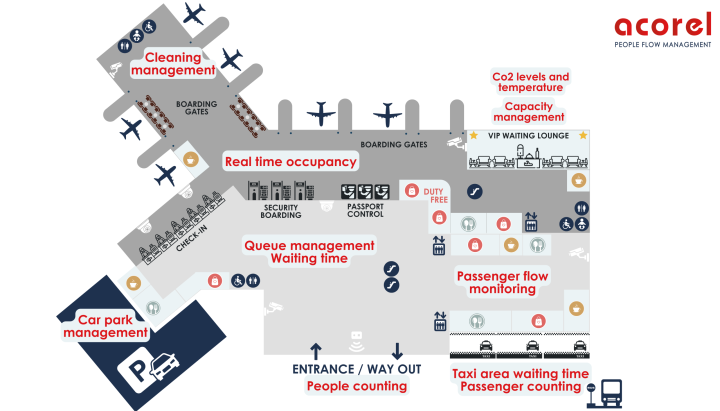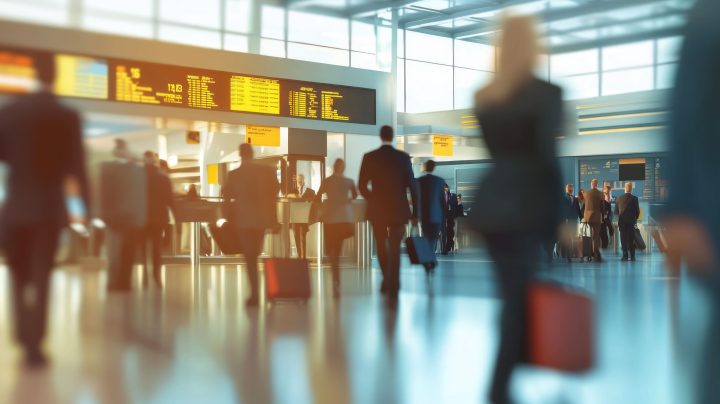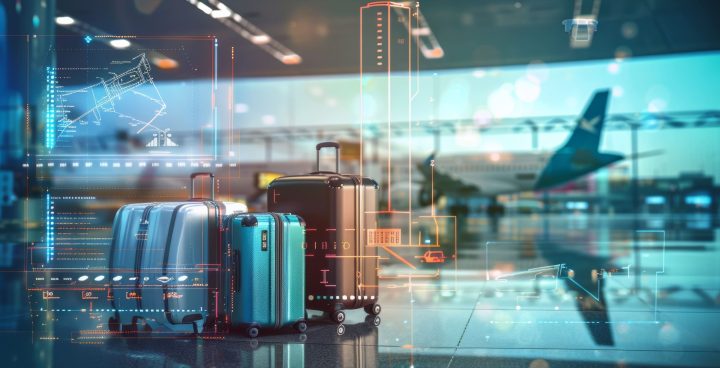A strategic priority for airport operators

According to the latest data from IATA (2024), global air traffic continues to grow significantly, with record levels expected in 2025. In this context, passengers increasingly demand fast, seamless, and personalised services.
Security checkpoints, check-in counters, boarding gates, and border controls are particularly sensitive zones where travellers often experience stress and perceive waiting time as wasted. Improving the passenger experience, therefore, goes beyond service offerings it also involves optimising time and flow management.
To meet these challenges, airports are turning to innovative technologies powered by artificial intelligence (AI). Two complementary approaches stand out for their impact on passenger journey fluidity and satisfaction: Computer Vision and the Internet of Things (IoT).
The ultimate goal? Streamline queue management and significantly improve the passenger experience in airports.
AI and Computer Vision: improving passenger flow management
How does it work?
Computer vision leverages existing CCTV cameras in airport terminals originally installed for safety purposes. With the addition of smart devices, these cameras can anonymously count passengers in real time without recording or storing any identifiable imagery.
Unlike traditional physical sensors (e.g. infrared, pressure mats, 2D/3D counters), computer vision requires no major infrastructure or construction. Its lightweight architecture enables fast deployment without disrupting operations.
What are the benefits for airports?
- Accurately measure waiting times
- Automatically detect long queues
- Optimise staff allocation in real time
- Respond quickly to avoid congestion

This makes Computer Vision particularly effective in critical areas such as security checks (PIF), border control (PAF), and check-in zones. It directly contributes to improving both operational efficiency and the overall passenger experience.
As one of the most tangible applications of AI in airports, computer vision analyses video feeds to interpret passenger behaviour, detect queues, and measure dwell times. By relying on machine learning algorithms, it transforms visual data into actionable insights in real time empowering airports to make better decisions, faster.
At Acorel, we provide airports with scalable, GDPR-compliant computer vision solutions that integrate easily into existing systems.
Discover our complete Computer Vision solution to manage airport flows.
IoT: monitor, predict, and act on passenger flows
The Internet of Things (IoT) refers to a network of smart devices that collect, transmit, and analyse data in real time. These sensors can be deployed throughout the airport, from parking areas and restrooms to lounges, retail spaces, and jet bridges.
They can monitor a wide range of parameters:
- Area occupancy levels
- Ambient conditions (noise, temperature, CO₂, etc.)
- Changes in footfall over time
- Equipment usage and performance
These insights enhance operational planning, help anticipate peak periods, and improve passenger comfort at every touchpoint.
Enhanced security with AI and IoT
AI-powered technologies and IoT devices also play a key role in enhancing airport security. Smart cameras and sensors can:
- Detect unusual crowding or gatherings
- Alert for abandoned baggage
- Flag suspicious behaviour patterns
These capabilities support more intelligent security operations while fully complying with GDPR and data protection regulations ensuring both safety and privacy.
Two technologies, one goal: a better airport experience
While distinct in function, Computer Vision and IoT serve the same purpose: helping airport operators address today’s critical challenges with smart, data-driven solutions.
Key advantages include:
- Reduced congestion in high-traffic areas
- More efficient staff deployment
- Greater responsiveness to passenger volume fluctuations
- Enhanced experience at every stage of the passenger journey
Acorel: supporting airports on their smart journey
At Acorel, we develop solutions that are non-intrusive, GDPR-compliant, and fully interoperable with existing infrastructures. Our goal is to deliver real operational value through technologies that adapt to all airport types.
- Lightweight deployment
- Real-time actionable data
- Modular, future-proof systems
- Designed for both regional and major international airports
The rise of smart airports
Airports such as Roissy Charles de Gaulle are leading the way, actively investing in IoT technologies to become smart airports. This evolution involves modernising infrastructure and optimising queue management at every stage.

Ready to modernise your airport’s operations?
Get in touch with our team or visit our dedicated page on passenger flow management for airports.
